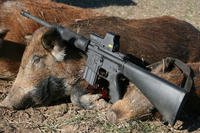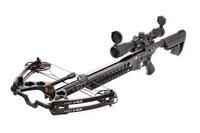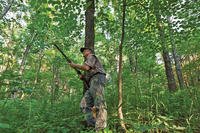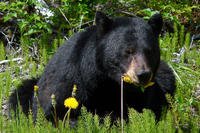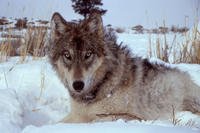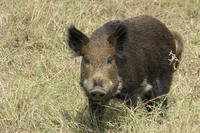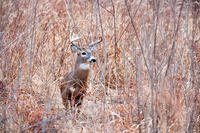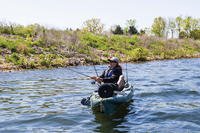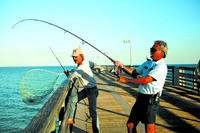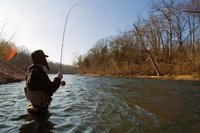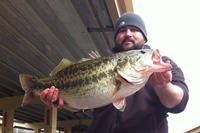There are times when breaking the rules makes all the difference.
by Steve Bartylla
It was one of those situations where you just don't expect much sympathy. Standing there inspecting my decoy pair were two shooter bucks. The one I wanted most was a glorious, perfectly clean 6x6. He was right there, practically gift-wrapped. The only problem was that I knew this tall, skinny-tined 160-class buck was only a 3½-year-old. I knew just as well that he'd absolutely explode given another year's growth.
The other buck wasn't half bad, either. This wide 8 was also a 3½-year old, but short brows limited his potential. As the 8 began intimidating the 12, making sure the 12 realized it would be him that fought my buck decoy for its doe, I knew it was the 8 I had to take.
A quick ears-back, neck-out posture and a charge was all it took to convince the 12 to yield. Shouldering the gun, I placed the crosshairs squarely on his chest as he marched in to meet my decoys. I squeezed off the shot and one of my most enjoyable hunts came to a triumphant conclusion. My calling, rattling and decoying techniques had paid off handsomely.
The Deadly Combo
In most cases, you achieve more success from rattling and calling when hunting pressure is low and the buck-to-doe ratios are tight. That only stands to reason, since the tight ratio increases competition and lack of pressure makes mature bucks more gullible.
Both were the case on this hunt. Working as a hunting consultant to Schuyler County, Illinois' Sugar Creek Outfitters, I was well aware of their doe harvest strategies. After all, I helped design them. The same was true with the lack of hunting pressure their approximately 10,000 acres of farms experienced — the 30 hunters they take annually didn't even scratch the surface of creating hunting pressure.
Without a doubt, those were key ingredients in that day's hunt. After all, when you're only the second person to hunt a farm all season long, the bucks are going to be more receptive to virtually anything you throw at them.
The setting was the next key ingredient. The farm consisted of three long, relatively narrow bean fields separated by overgrown valleys and flanked by big woods. You couldn't help seeing deer sitting on one of the fields.
However, one of the challenges was that deer literally came from everywhere. Getting one within weapon range wasn't an issue, but getting the [i]right[/i] one close enough always is — and that's where the decoys came in. I knew the odds were good that the decoys would be covered up with does long before a buck would emerge. In many cases, this is a problem.
I wasn't concerned, though. I was armed with a pair of Custom Robotic Wildlife decoys. In essence, these are legitimate, full-body-mount deer. They utilize actual deer hides, and in my opinion there just aren't more realistic or effective decoys on the market. Though I was not using the remote-controlled robotics on this hunt, the ability to turn their heads and flick their tails often seals the deal.
Without the robotics, I was betting that the does would question if the decoys were real. After all, real deer move. However, I was also banking on the ultra-real appearance to help set them at ease. The combination should draw them in, head bobbing and snapping as they came, but not scare them off.
It worked to perfection. The does and young bucks swarmed around the decoys like bait fish swarm around cover or food.
The choice of using a decoy pair was for the bucks. By placing a bedded doe approximately 50 yards out from my position with a buck standing guard over her, I sent a powerful message. That positioning just screams, "There's a buck tending an estrus doe! If you want her, come beat up the 130-ish buck and she's all yours!"
All those deer gathering around the decoys presented one problem, though. I knew I might have to do some calling to pull a buck out of the timber. To do so, it'd have to be loud, and there were about 25 deer milling around the decoys.
I decided to do a little prep work on the deer. My first calling sequence was very light — just a couple grunts and some brief, light rattling. As expected, it got every deer's attention. Still, they eventually went back to feeding.
About 20 minutes later, I started my second sequence, a little louder. Again, it got their attention, but not for long. By the time I hit my fifth sequence, they didn't even bother raising their heads. I had successfully gotten them to accept it as nothing of importance.
Not long after that final sequence, I spotted the bucks chasing a doe in the woods behind me. I could tell right away they were good bucks, but darkness was approaching fast and I needed them here sooner rather than later.
That's when I decided to press my luck. Throwing caution to the wind, I proceeded to produce an all-out calling and rattling sequence. Not only did it get the bucks' attention, but the nearby school virtually ignored it. After all, they'd heard it five times already.
Though the calling was what brought the bucks to the edge of shooting range, it was the decoys that sealed the deal. As the bucks approached the field edge, they stopped and surveyed the deer out in front of my stand. The second they saw the decoys, their demeanor instantly changed. Bristling up, they began their march in, not even momentarily hanging up until both were well within shooting range.
Decoys are far more commonly used in bowhunting, and they are very effective then. However, the fact that many mature bucks do indeed hang up is what makes them so perfectly suited for certain firearms hunting situations.
Since most bucks hang between 50 to 100 yards out from the decoy, placing decoys 50 yards in front of the stand not only creates lower odds of the deer busting the hunter, but also gets the majority of bucks within 150 yards. That's easy shooting range, and bucks most often stand there and pose for the shot. Really, what more could you ask for?
Extreme Calling
You might recall that I mentioned that those types of aggressive tactics work best on tight buck-to-doe ratios that experience very limited hunting pressure. Though that's very true, aggressive tactics can also work well on heavily pressured bucks, assuming you can recognize the right situation.
I found myself in that spot last season, during Wisconsin's bow season. Having picked up a small lease near my home for the convenience factor, I had a hunting spot just minutes from my door. The area wasn't great for producing big bucks and it was surrounded by extremely heavy hunting pressure. Still, it was nice to have a hunting spot for those quick afternoon sits.
That was all I had time for that particular late October afternoon. I'd barely settled into a stand when I saw the doe. Through the binocular I could see she was alternating between fanning herself and waving her tail, a sure sign that she was about to come into an early estrous.
As I scanned the surrounding thickets, I saw the wide rack of a 10-pointer approaching on a trot. I could only hope the doe would lead his chase over by me.
Like a dream, here they came — until a 2½-year-old buck joined the fun. Mr. Big immediately turned his attention to driving the new guy off. As soon as he succeeded and began returning to the doe, I grabbed my Primos Buck Growl. No, I've never heard a buck "growl" in the woods, but it's the loudest buck grunt on the market and I needed to get this guy's attention [i]now[/i].
After three loud grunts stopped him, I pinched my lower lip to my upper teeth and forced out my best phut, phut, fffffoooouuuuuuuu of a snort-wheeze I could muster. Sure enough, my challenge was all it took to reel Mr. Big in. That was, until he intercepted another small buck and drove him off, before heading back toward the doe.
Just as he was returning to her, I hit him with another three-grunt, snort-wheeze challenge. It didn't work this time, so I grabbed the rattling antlers and crashed them together for 10 seconds. He came charging in on a mission. Unfortunately, a branch saved his life by blocking my shot opportunity.
Thinking all was lost, I gave it one last shot. I began with four loud grunts, then flipping The Big Can three times, adding an estrus doe bleat. After two snort-wheezes, I crashed the antlers together again, going nuts for over 30 seconds. Snatching my bow, I really believed I'd had my chance and it was gone.
That wasn't the case. He came blowing in a third time. Coming to full draw, I darn near had to scream a mouth grunt to stop him. Picking my spot, I sent the arrow blowing though him. Almost unbelievably, I'd managed to call a mature, heavily pressured buck in three times in just minutes!
The real key to this was that he was in full protection mode. He knew every buck in the area would be after this early doe. Even in heavy-hunting-pressure situations, when a buck's mind is set on defending his not-quite-ready doe, throw the kitchen sink at him. The seemingly impossible just might become possible.
The Safety Factor
- Only decoy on private land and only if the other hunters on the land know what you're up to.
- Drape your dekes in a hunter-orange vest while you're handling them.
- Place decoys in the open and don't carry them in while assembled.
- Set up decoys after first light and take them down before sunset, to keep you visible to other hunters.
- Never place decoys within sight of a road to protect yourself from the idiots of the world.
Decoy Tips
To pull off successful decoying, several little things can be a big help. The first is to provide movement. Decoys that have the ability to move both their heads and tails provide a very significant advantage.
Attaching a strip of white cloth or factory-provided strips to the ears and tails of traditional decoys helps in that area. That way, when the wind blows, they provide a flutter of movement.
Another helpful tip is placing the appropriate deer urine very near the decoy's back side. You don't want to place it on the decoy, but very close to it.
Finally, odor control on decoys is a must. After all, the deer's noses will be working overtime as they approach the decoy. Foreign odors ruin more otherwise great setups than most realize.
With those tips in mind, the decoy manufactures below offer every option one could hope for, from top-of-the-line to quick, easy and relatively inexpensive:
Custom Robotic Wildlife Decoys
Primos
Delta Targets
Carry-Lite
Come Alive Decoy Products
Flambeau Outdoors.com
Montana Decoys
